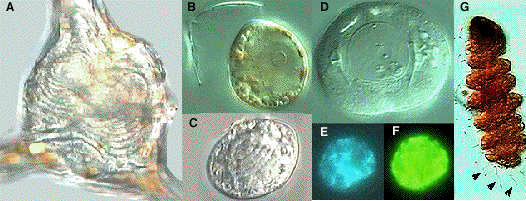
A = Ceratium with the trophont; B = Early stage in Pentapharsodinium; C=Mature trophont in a gymnodinioid species; D = Early stage in Actiniscus; E&F = Trophont in epifluor. microscope; G = Vermiforme stage (flagella=arrowheads). A-D and G (DIC); G=In Lugol
Life-form: Parasite
Size: .
Resting spore:
Note: Parasite in the cytoplasm or nucleus of many different species of dinoflagellates. A. ceratii may represent a cluster of relatively host-specific species according to Coats et al. (1996).
Distinctive features: The mature trophont resembles a classic beehive in shape
Similar species:
Distribution: Widely
Literature:
Cachon, J. 1964. Contribution a l'étude des Péridinies
parasites. Cytologie, cycles évolutifs. Ann. Sci. Nat., 12
ser. 6: 1-158.
Cachon, J. & Cachon, M. 1987. Parasitic dinoflagellates. In Taylor, F. J. R. (Ed.). Biology of dinoflagellates. Blackwell, New York. pp. 571-610
Coats, D. W., Adam, E. J., Gallegos, C. L. & Hedrick, S. 1996. Parasitism of photosynthetic dinoflagellates in a shallow subestuary of Chesapeake Bay, USA. Aquat. Microb. Ecol. 11: 1-9.
Fritz, L. & Nass, M. 1992. Development of the endoparasitic dinoflagellate Amoebophrya ceratii within host dinoflagellate species. J. Phycol. 28: 312-320.
Taylor, F. J. R. 1968. Parasitism of the toxin-producing dinoflagellate Gonyaulax catenella by the endoparasitic dinoflagellate Amoebophrya ceratii. J. Fish. Res. Bd. Can. 25: 2241-2245.